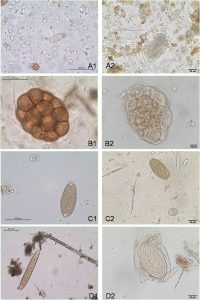Internal Parasites
Parasites
A parasite is an organism that lives on or in a host and gets its food from or at the expense of its host. Parasites can cause disease in both animals and people. Some parasites can be transmitted between people and animals. These are called zoonotic infections.
Internal Parasites
Some of the more common intestinal parasites in reptiles are roundworms, hookworms and pinworms. These types of parasites can be a serious problem particularly for the reptile’s health and wellbeing. Many reptiles captured from the wild often already have parasites so it is best to have them checked by a veterinarian and has a fecal test done. If a captive-bred reptile comes down with a parasitic infection it is usually through contact with other reptiles or contaminated objects and environments, or by eating infected food items. Reptile parasites reproduce rapidly and can cause devastating illness and quickly spread throughout an entire collection.
Worms are one of the most common intestinal parasites. Among reptiles, the most common infections are roundworms (including ascarids), hookworms and pinworms. Lizards, in particular, are likely to contract roundworms.
Symptoms
Reptiles with intestinal parasites frequently have the following symptoms:
- Poor appetite
- Weight loss
- Vomiting or regurgitation
- Abnormal appearing stools
- Diarrhea
Worms may or may not be visible to the naked eye. In some cases you may see parasites in the reptile’s feces or vomit, but even if they are not visible they can certainly still be present within the animal’s body.
The larval forms of some types of intestinal parasites migrate through the lungs and can cause respiratory signs and pneumonia. Death is possible with severe infections, particularly when certain types of microorganisms are involved.
Causes
- Agitation
- Head rubbing head
- Anorexia
- Lethargy
- Dehydration
- Anemia
- In severe cases death
Diagnosis
- Physical exam by a reptile veterinarian
- Clinical signs
- Fresh fecal sample under the microscope or send it to a laboratory for testing
Treatment
Treatment for intestinal parasitism involves the use of anthelmintics or dewormers. Some antibiotics are effective in treating parasitic infections but many do not respond well with this treatment. Follow directions from your veterinarian for the best course of action.
Prevention
- Keep your reptile away from other animals with unknown health history
- Keep enclosure clean
- Take it to a veterinarian regularly for checkups and de-wormings

Different parasite eggs found in snakes fecal samples
A1)Sarcocystis spp. sporocysts and a digenean trematode egg (middle) within a direct smear of a Green Python (Morelia viridis)
A2) Sarcocystis spp. sporocysts, a digenean trematode egg (top) and a strongyle egg (Kalicephalus-/Herpetostrongylus-like; bottom) from a Green Python (Morelia viridis).
B1) Charasteristic egg cluster (Kapsulotaenia spp.) within a direct smear of a Green Python (Morelia viridis)
B2) characteristic egg cluster (Kapsulotaenia spp.) in a Green Python (Morelia viridis)
C1) Eimeria spp. oocyst (rodent-specific ‘pseudoparasite’, only transiting the intestinal tract; top) and Capillaria (Syn. Ophidiocapillaria) spp. egg within a flotation of a Green Python (Morelia viridis)
C2) Eimeria spp. oocyst (rodent-specific ‘pseudoparasite’, only transiting the intestinal tract; bottom) and Capillaria (Syn. Ophidiocapillaria) spp. egg in a Royal python (Python regius)
D1) Three heterakid eggs (on left) and a mite egg (Myocoptes-musculinus-like; middle; rodent-specific fur mite egg transiting the digestive tract) within a flotation of a Green Python (Morelia viridis)
D2) unidentified egg resembling Acanthocephala spp. eggs in a Green Python (Morelia viridis).
For more information about reptile parasites visit the Merck Veterinary Manual at this link.
